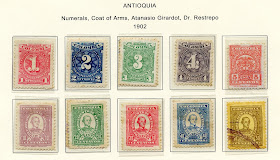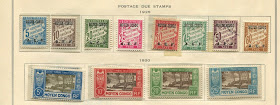1886 Scott 56 2 1/2c black/orange
"Coat of Arms"
Into the Deep Blue"Coat of Arms"
How can one tell that one is in the (exciting to me!) philatelic backwaters of the hobby? Perhaps an unconventional way is comparing the Scott 1840-1940 classic catalogue over the years. I believe Scott began replacing black & white stamp illustrations around 2004. By 2011, it was rare to find a black & white stamp illustration, because they had been replaced with colored ones. Yet, with the Colombian States, the 2011 catalogue still had 51 B&W illustrations - Wow! My 2020 Classic catalogue now has none - finally. !!
The original post....
Colombian States & BB Checklist
Colombia (Map by Gerben van Gelder )
Stamp Issuing States in Red
If you enjoy exploring the backwaters of an interesting era, then the Colombian States offer much!
From my original Colombian States post...
"The United States of Colombia (1862-85) consisted of nine original States: Antioquia, Bolivar, Boyaca, Cundinamarca, Panama, Santander, Cauca*, Magdalena*, and Tolima. Naturally, all of them issued stamps as early as 1863. After a new constitution was adopted in 1886, the States became Departments, losing their sovereignty. But the Departments retained some rights, including issuing stamps as late as 1904. It should be noted that Panama left the Republic in 1903.
* Cauca and Magdalena did issue "stamps", but they are not presently listed in Scott."
From my original Colombian States post...
"The United States of Colombia (1862-85) consisted of nine original States: Antioquia, Bolivar, Boyaca, Cundinamarca, Panama, Santander, Cauca*, Magdalena*, and Tolima. Naturally, all of them issued stamps as early as 1863. After a new constitution was adopted in 1886, the States became Departments, losing their sovereignty. But the Departments retained some rights, including issuing stamps as late as 1904. It should be noted that Panama left the Republic in 1903.
* Cauca and Magdalena did issue "stamps", but they are not presently listed in Scott."
I thought we would revisit these Colombian States.
This is actually a big topic. I will illustrate some (what I have) of the stamp issues from each State/Department. To make it manageable, I will publish several posts.
A Closer Look - Antioquia
100 Centavo = 1 Peso
1873 Scott 16 50c blue
Imperforate, Lithographed
Imperforate, Lithographed
Most issues of Antioquia (Medellin the most prominent town) and other Colombian States stamps were lithographic printed, which give them a flat, somewhat primitive quality. Of course, Colombia itself had mostly lithographic issues during this era.
I actually wish I had more Colombian States stamps, as I find the issues fascinating, and frankly not that well known, and somewhat hard to obtain. And yet the CV prices tend to be in the $1's and $10's (There are exceptions of course).
Antioquia had an 1868 issue (four stamps- CV $500-$1000), an 1869 issue (six stamps - CV $6-$20+), and then an 1873 issue (eight stamps, eight designs - CV $3+-$40+), of which the above is a member.
I actually wish I had more Colombian States stamps, as I find the issues fascinating, and frankly not that well known, and somewhat hard to obtain. And yet the CV prices tend to be in the $1's and $10's (There are exceptions of course).
Antioquia had an 1868 issue (four stamps- CV $500-$1000), an 1869 issue (six stamps - CV $6-$20+), and then an 1873 issue (eight stamps, eight designs - CV $3+-$40+), of which the above is a member.
1886 Scott 61 50c yellow brown/buff
"Coat of Arms", Lithographed
"Coat of Arms", Lithographed
There were three more issues produced (1875-85- nine stamps; 1878-85 -eight stamps; 1883-85 - seven stamps) before this shown 1886 stamp (eight stamps, one design - CV $1-$9). Recall that 1886 is when the "States" became "Departments" with a new constitution, and the governors were appointed by the President of the Republic. Perhaps this issue signaled the new era.
1887-88 Scott 64 1c red/violet
"Coat of Arms", Lithographed
"Coat of Arms", Lithographed
In 1887-88, five more stamps were issued, similar in design to the 1886 issue, but in different colors. CV is <$1-$3+.
Just like Colombian stamps, there are forgeries extant for the primitive lithographic Colombian States issues also. (I can't guarantee that all of these illustrated stamps are genuine.)
For instance the above 1887-88 1c red/violet and the 1886 header stamp 2 1/2c black/orange are on the suspect list.
Here is another list of stamps where forgeries need to ruled out...
1868: 2½ 5 10c 1p
1869–73: 2½c–1p 1c–5p
1869–72: 2½c–1p
1869–73: 5 10 1p 5c
1873: 5p
1875–7: 1 1 1c
1889: 2½ 2½ 5 5c
Just like Colombian stamps, there are forgeries extant for the primitive lithographic Colombian States issues also. (I can't guarantee that all of these illustrated stamps are genuine.)
For instance the above 1887-88 1c red/violet and the 1886 header stamp 2 1/2c black/orange are on the suspect list.
Here is another list of stamps where forgeries need to ruled out...
1868: 2½ 5 10c 1p
1869–73: 2½c–1p 1c–5p
1869–72: 2½c–1p
1869–73: 5 10 1p 5c
1873: 5p
1875–7: 1 1 1c
1889: 2½ 2½ 5 5c
1889 Scott 75 5c black/yellow
Lithographed
Lithographed
In 1889, the first perforated (13 1/2) issue for Antioquia was released (four stamps, one design). CV is <$1. Note the stamp know states "Departamento".
The "errors" of color found for the issue are essays or possibly reprints.
The "errors" of color found for the issue are essays or possibly reprints.
1890 Scott 85 5c black/orange
Typeset, Perf 14
Typeset, Perf 14
A five stamp provisional issue (four designs) was typeset in 1890. Scott states there are 20 varieties of the 5c denomination. Talk about primitive! CV is $4+-$10+.
Printed by the 'IMPRENTA DEL DEPARTAMENTO' in Medellín, as a shortage of stamps existed.
Printed by the 'IMPRENTA DEL DEPARTAMENTO' in Medellín, as a shortage of stamps existed.
1892 Scott 90 2 1/2c purple/lilac
Lithographed, Perf 13 1/2
Lithographed, Perf 13 1/2
In 1892, a lithographic three stamp, one design was issued.
1893 Scott 95 5c vermilion
Lithographed
Lithographed
And in 1893, four more stamps in the same design, but different colors, were published.
CV for both the 1892 & 1893 issues are <$1-$2+.
CV for both the 1892 & 1893 issues are <$1-$2+.
1896 Scott 108 20c blue
Lithographed, Perf 14
Lithographed, Perf 14
In 1896, a twenty stamp one design issue was released.
1896 Issue Scott 97-108
Although lithographed, the stamps have an almost engraved appearance.
CV ranges from <$1 to $200.
CV ranges from <$1 to $200.
1899 Scott 127 2p olive gray
"General Jose Maria Cordoba"
"General Jose Maria Cordoba"
In 1899, an eleven stamp lithographic issue with one design (as above) was released. They are still extremely ubiquitous in general stamp mixtures, and for many collectors, would represent their first introduction to Antioquia. I noticed when I had many Big Blue albums as feeder albums, invariably there would be some of these Antioquia stamps in them.
1901 Scott 129 1c ultramarine
Typeset, Perf 12
Typeset, Perf 12
In 1901, another typeset issue was released (five stamps, three designs). There are four varieties of the 1c denomination, according to Scott. Do you like primitive? I do. ;-) CV is <$1-$9.
1902 Scott 137 20c gray green
"Atanasio Girardot", Lithographed
"Atanasio Girardot", Lithographed
The 1902 set (ten stamps, four designs) is very inexpensive (CV <$1).
1902 Issue Scott 131-140
But what is truly more attractive - a set produced by a well know printing house in New York or London for a country, or a set that is produced "in house"? I vote for the latter. ;-)
1903 Scott 143A 1c blue
Lithographed
Lithographed
In 1903, two more stamps were issued, in different colors, with the same design as the 1902 set.
1903-04 Scott 152 1p olive gray
"Custodio Garcia Rovira"
"Custodio Garcia Rovira"
In 1903-04, another thirteen stamp, three design issue was released, using lithography.
1903-04 Issue Scott 145-152
CV is <$1-$10+. This 1903-04 issue would prove to be the last of Antioquia's output.
Registration 1899 Scott F3 2 1/2c dull blue
"Cordoba", Lithographed
"Cordoba", Lithographed
An 1899 Registration stamp...
Acknowledgment of Receipt 1902-03 Scott H1 5c black/rose
Lithography
Lithography
An Acknowledgement of Receipt stamp....
Late Fee 1901 Scott I2 2 1/2c red violet
Typeset
Typeset
A Late Fee stamp, in primitive typeset....
1896 Scott 55 1c green/pink
"Coat of Arms', Lithographed
Out of the Blue"Coat of Arms', Lithographed
Hopefully, this review of the primitive, but fascinating issues of Antioquia was found interesting!
Comments Appreciated!


































































